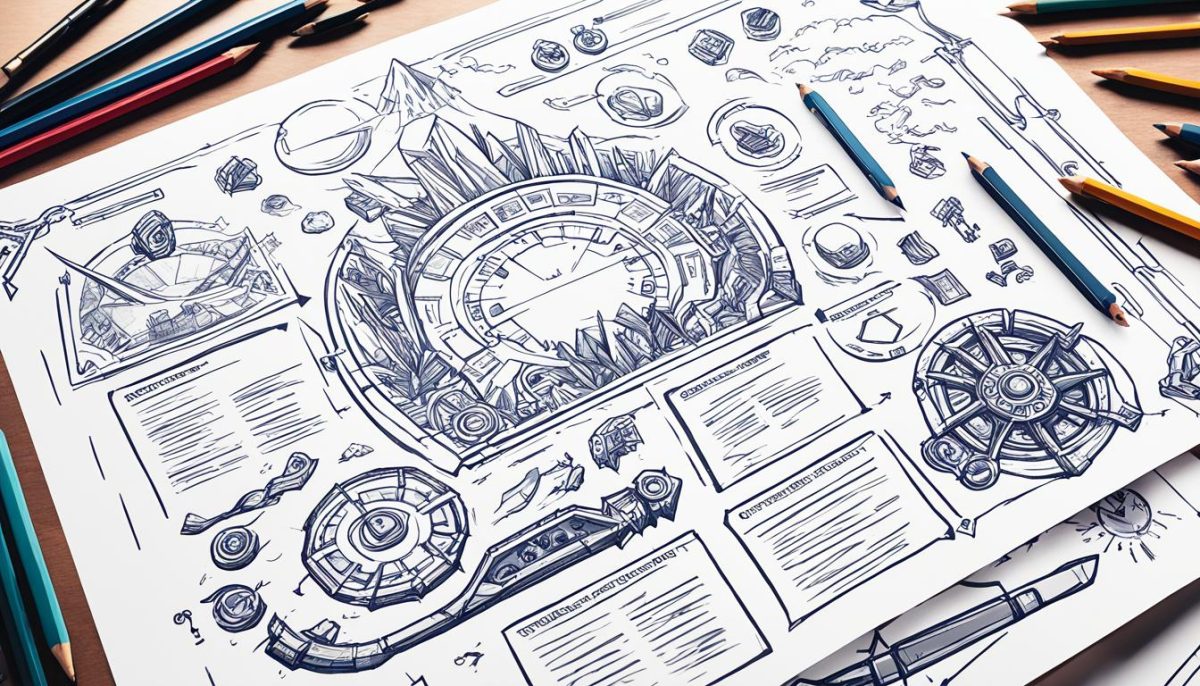Welcome to our guide on how to make RPG games! Whether you’re an aspiring game developer or simply interested in learning about game development, this comprehensive guide will provide you with valuable insights and tips to get started on your RPG game-making journey.
Game development is an exciting and challenging process that requires a combination of creativity, technical skills, and attention to detail. In this section, we will explore the process and steps involved in making RPG games, empowering you to bring your own unique game ideas to life.
From developing captivating storylines and characters to creating immersive gameplay mechanics and stunning visuals, making RPG games involves a variety of elements that come together to create memorable gaming experiences. Whether you’re a fan of classic turn-based RPGs or prefer more action-oriented gameplay, this guide will equip you with the knowledge and tools necessary to create the game of your dreams.
Throughout this section, we will cover essential topics such as game design, coding, graphics, sound design, testing, and more. By the end, you’ll have a solid understanding of the entire game development process and be ready to embark on your RPG game-making journey.
So, if you’ve ever wondered how to make RPG games or have been itching to bring your unique game concept to life, you’ve come to the right place. Let’s dive in and unlock the secrets of RPG game development together!
Planning Your RPG Game
Before diving into the development process, it’s essential to plan your RPG game effectively. By understanding the key elements of game design, including game mechanics, storytelling, and character development, you’ll lay a solid foundation for your game’s success.
Game Design
Game design is the backbone of any RPG game. It involves creating engaging gameplay mechanics that capture the player’s interest and keep them immersed in the world you’ve created. Consider the type of gameplay you want to offer – turn-based combat, open-world exploration, puzzle-solving, or a combination of different mechanics. Strive for a balance between challenge and enjoyment, providing the player with a rewarding experience throughout their journey.
Additionally, game design encompasses level design, where you create diverse environments that challenge the player while also complementing the overall narrative. Think about the layout, obstacles, puzzles, and secrets that players can discover as they progress through your game.
Storytelling
A captivating story is a crucial aspect of any RPG game. Develop your game’s narrative arc, fleshing out the world and the main storyline. Consider plot twists, character motivations, and the choices and consequences that players will face. Engage players emotionally by developing a rich lore and backstory for your game universe.
Remember to create compelling side quests and subplots, providing players with meaningful interactions, character development, and additional content to explore. Strong storytelling enhances player engagement and keeps them invested in the game.
Character Development
Memorable characters are the heart and soul of any RPG game. Design diverse and relatable characters, each with their own unique personalities, strengths, weaknesses, and backstories. Give players the opportunity to connect with these characters and forge meaningful relationships throughout the game.
You can further enhance character development by incorporating branching dialogue options, allowing players to shape the relationships and outcomes based on their choices. Develop character progression systems, such as leveling up, skill trees, and equipment upgrades, to give players a sense of growth and customization.

Planning your RPG game involves thoughtful consideration of game design, storytelling, and character development. By focusing on these key elements, you’ll create an immersive and engaging experience for players. In the next section, we’ll discuss the technical aspects of developing your RPG game.
Developing Your RPG Game
With the planning stage complete, it’s time to delve into the exciting development process of your RPG game. This section will guide you through the technical aspects involved in bringing your game to life, including:
- Coding and programming
- Graphics design
- Sound design
- Thorough testing and debugging
The coding and programming stage is where the magic happens. Using languages like C++, Python, or Unity’s C#, you’ll craft the core mechanics of your game. This is where your creativity blends with technical skills to create interactive gameplay, intriguing non-player characters (NPCs), and engaging quests.
Graphics design plays a crucial role in enhancing the visual appeal of your RPG game. Whether you opt for pixel art, 2D illustrations, or 3D models, attention to detail and artistic expression are key. By creating captivating environments, characters, and special effects, you’ll immerse players in your game’s world.
Sound design adds depth and realism to your RPG game. From ambient background music and dialogue to unique sound effects, audio brings the game to life and enhances the overall player experience. Creating an immersive soundscape ensures players are fully immersed in the game’s atmosphere.
Thorough testing and debugging are essential to ensure a polished final product. This stage involves rigorous testing to identify and fix any bugs, glitches, or performance issues. By conducting extensive playtesting and addressing user feedback, you can refine and optimize your RPG game.
Remember, the development process requires a balance of creativity and technical expertise. Pay attention to every detail, from coding the core mechanics to designing visually stunning graphics and creating captivating soundscapes. Test your game thoroughly to weed out any potential issues and deliver a polished, enjoyable experience for players.
By following best practices in coding, graphics design, sound design, and testing, you can create an RPG game that captivates players and leaves a lasting impression. The coming sections will guide you through promoting and launching your game, but first, let’s explore the technical aspects of game development.

Promoting and Launching Your RPG Game
Once your RPG game is developed and tested, it’s time to shift your focus towards effectively promoting and launching it. Implementing strategic marketing techniques is essential to create buzz, reach your target audience, and ensure the success of your game.
One powerful marketing strategy is leveraging social media platforms. Create engaging content that highlights your game’s unique features, characters, and gameplay. Encourage your audience to share and spread the word about your game by organizing giveaways or contests. Building an active community on social media can significantly boost your game’s visibility and attract potential players.
In addition to social media, actively engage with gaming communities. Participate in forums and discussions, share behind-the-scenes insights, and respond to player feedback. Collaborating with influential gamers or streamers can also give your game a wider reach and increase exposure.
Furthermore, consider launching your RPG game on prominent gaming platforms. By offering your game on platforms like Steam or mobile app stores, you can tap into their existing user base and benefit from their built-in marketing and promotional tools. Make sure to optimize your game’s description, screenshots, and videos to entice potential players and stand out from the competition.

